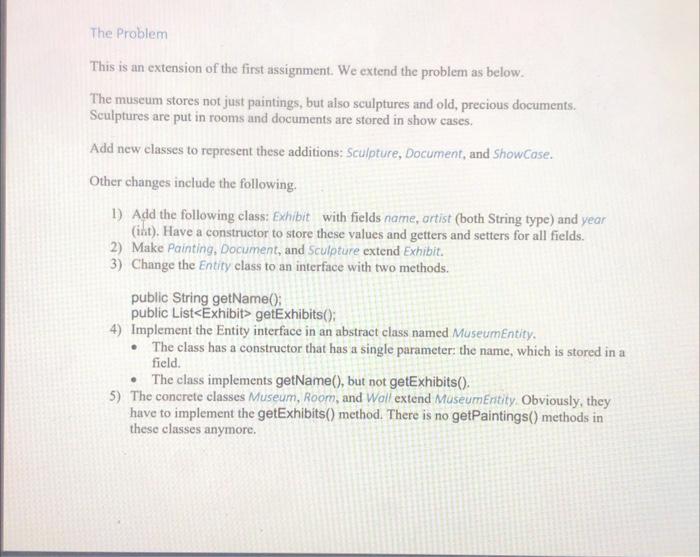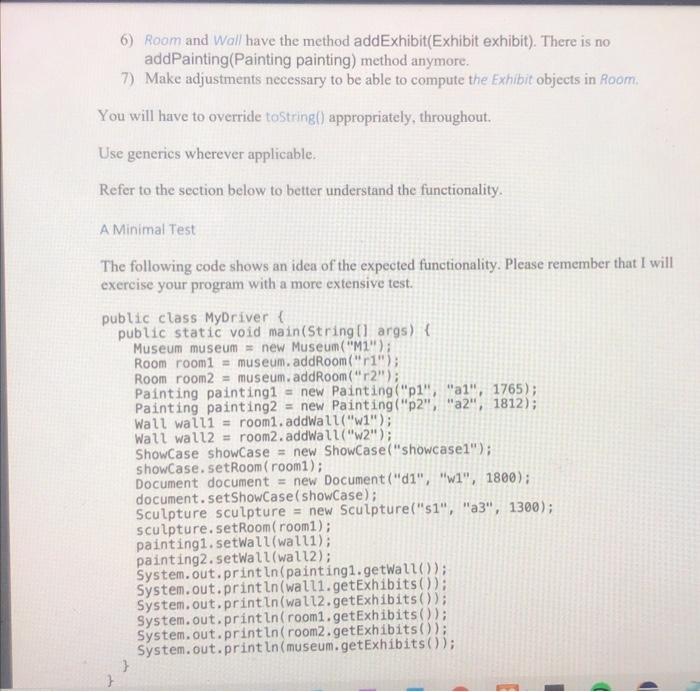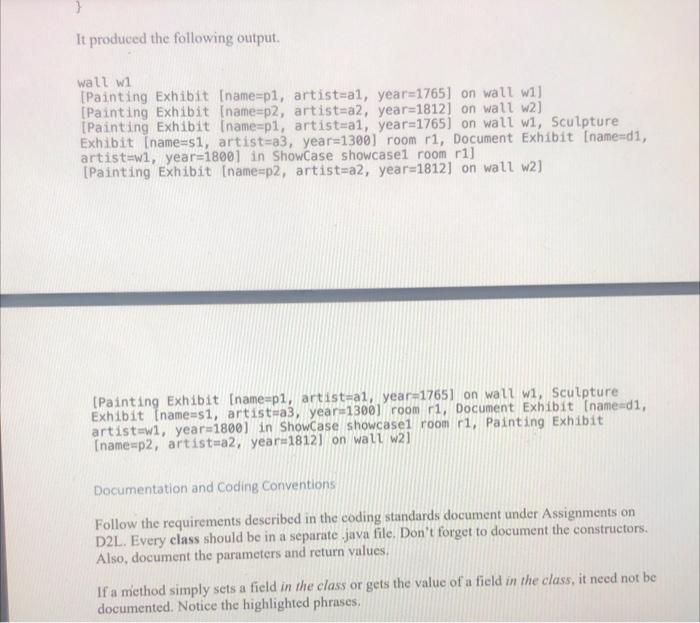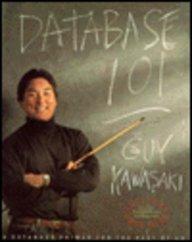Reposted because of an incorrect answer. this assignment is an extension of a previous assignment and I provided the code for that assignment here. please answer using JAVA and add comments for explanation. thanks



The Problem This is an extension of the first assignment. We extend the problem as below. The museum stores not just paintings, but also sculptures and old, precious documents. Sculptures are put in rooms and documents are stored in show cases. Add new classes to represent these additions: Sculpture, Document, and Showcase. Other changes include the following. 1) Add the following class: Exhibit with fields name, artist (both String type) and year (int). Have a constructor to store these values and getters and setters for all fields. 2) Make Painting, Document, and Sculpture extend Exhibit. 3) Change the Entity class to an interface with two methods. public String getName(); public List
getExhibits(); 4) Implement the Entity interface in an abstract class named MuseumEntity. The class has a constructor that has a single parameter: the name, which is stored in a field. The class implements getName(), but not getExhibits(). 5) The concrete classes Museum, Room, and Wall extend MuseumEntity Obviously, they have to implement the getExhibits() method. There is no getPaintings() methods in these classes anymore 6) Room and Wall have the method addExhibit(Exhibit exhibit). There is no addPainting(Painting painting) method anymore, 7) Make adjustments necessary to be able to compute the Exhibit objects in Room, You will have to override toString() appropriately, throughout. Use generics wherever applicable. Refer to the section below to better understand the functionality. A Minimal Test The following code shows an idea of the expected functionality. Please remember that I will exercise your program with a more extensive test. public class MyDriver { public static void main(String() args) { Museum museum = new Museum ("M1"); Room room1 = museum.addRoom("1"); Room room2 = museum, addRoom("r2"); Painting painting1 = new Painting("p1", "a1", 1765); Painting painting2 = new Painting ("p2") "a2", 1812); Wall walli = room1.addWall("w1"); Wall wall2 = room2. addWall("W2"); Showcase showcase = new Showcase("showcase1"); showCase. setRoom(room); Document document = new Document("d1", "W1", 1800); document.setShowCase(showCase); Sculpture sculpture = new Sculpture("51", "a3", 1300); sculpture.setRoom(room1); paintingi.setwall(walli); painting2.setWall(wall2); System.out.println(painting1.getWall(); System.out.println(walli.getExhibits()); System.out.println(wall2.getExhibits()); System.out.println(room1.getExhibits()); System.out.println( room2.getExhibits()); System.out.println(museum.getExhibits()); 3 I 1 - It produced the following output. wall w [Painting Exhibit (name=p1, artist=a1, year=1765) on wall w1] [Painting Exhibit (name=p2, artist=a2, year=1812) on wall w2] (Painting Exhibit name=p1, artistual, year=1765) on wall wi, Sculpture Exhibit [name=s1, artist=a3, year=1300) room ri, Document Exhibit [namendi, artist=wl, year=1800] in Showcase showcasel room ri] [Painting Exhibit name=p2, artistwa2, year=1812) on wall w2] [Painting Exhibit (name=p1, artist=al, year=1765] on wall wi, Sculpture Exhibit Iname=$1, artist=a3, year=1300) room r1, Document Exhibit (name=d1, artist=wi, year=1800) in Showcase Showcasei room r1, Painting Exhibit Iname=p2, artistua2, year=1812) on wall w21 Documentation and Coding Conventions Follow the requirements described in the coding standards document under Assignments on D2L. Every class should be in a separate java file. Don't forget to document the constructors. Also, document the parameters and return values. If a method simply sets a field in the class or gets the value of'a field in the class, it need not be documented. Notice the highlighted phrases









